The Carrick-a-Rede Rope Bridge is a popular attraction in County Antrim along the Giant’s Causeway Coastal Route, perfect for adventurers and nature enthusiasts. Built in 1755 by fishermen for salmon fishing, this iconic bridge spans 66 feet and is suspended 100 feet above the sea, offering breathtaking coastline views. In this article, I will share my experience and advice on how to plan your visit.
Table of Contents
The Fascinating History of Carrick-a-Rede Rope Bridge
Suspended nearly 100 feet above the crashing waves of the Atlantic Ocean, this iconic bridge connects the mainland to Carrick-a-Rede Island. The name Carrick-a-Rede comes from the Scottish Gaelic phrase “Carraig-a-Rade,” meaning “The Rock in the Road”. Not surprisingly, this small island was really a rock in the salmons’ sea road!
PLAN YOUR TRIP TO NORTHERN IRELAND
Stay connected in Northern Ireland with a giffgaff free SIM or an Airalo eSim for data coverage that works seamlessly throughout the whole UK. Plus, dive into everything you need to know about renting a car in Ireland, so you can easily explore incredible attractions like the Giant’s Causeway.
Local fishermen relied on this spot as one of the best locations for catching salmon in Northern Ireland. Then, in 1755, salmon fishermen erected the Carrick-a-Rede Rope Bridge. For over 250 years, they have crossed this chasm with the rushing sea below in their quest for salmon.
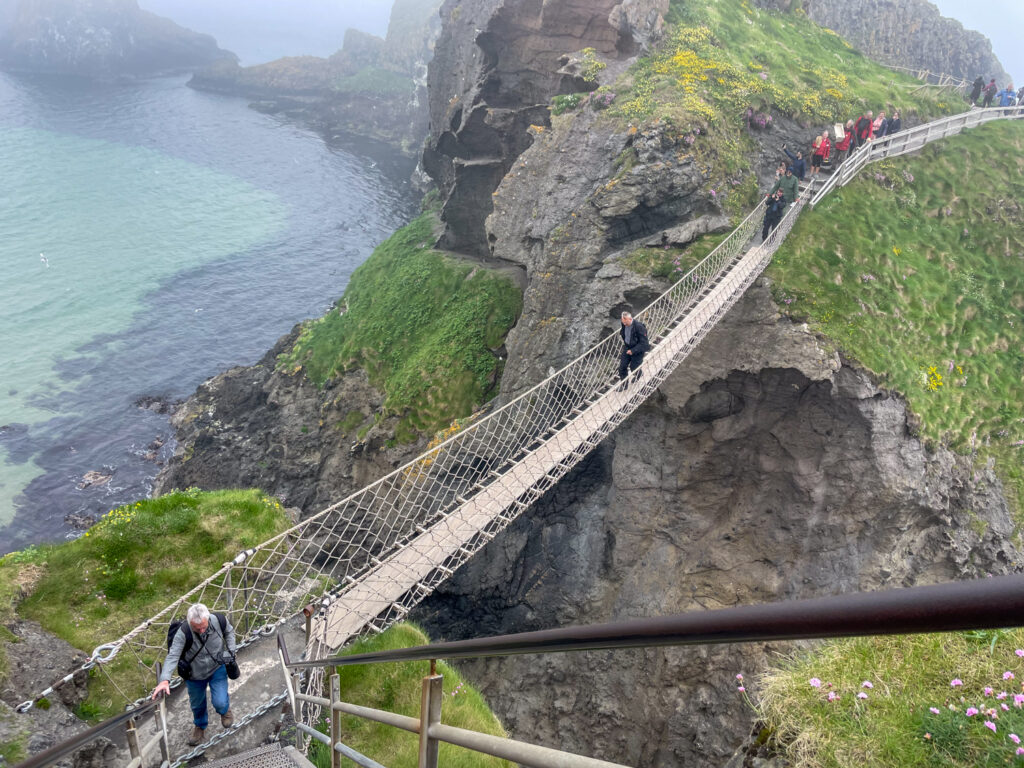
Salmon Fishing at Carrick-a-Rede
Salmon fishing has deep roots along the Causeway Coast, with records dating back to around 1620. This stretch of coastline quickly earned a reputation as one of the best fishing grounds, and before long, fishermen began setting up cottages along the shore to call it home.
The importance of salmon fishing in the area grew even further in the early 1600s. The fishing rights offered by King James I and VI to Protestant traders from London encouraged them to settle in Northern Ireland and were a game-changer for the local economy. It laid the foundation for the fishing community that would thrive here for centuries.
By the 19th century, the town of Ballintoy was a hub of fishing activity, with more than 80 fishermen, including 21 dedicated salmon fishers and 10 fish carriers. It wasn’t uncommon to see catches of up to 300 salmon in a single day!
Sadly, this once-thriving industry has seen a steep decline. The salmon population decreased sharply due to fishing pressure at sea, river pollution, and environmental changes. The last salmon caught at Carrick-a-Rede was in 2002, marking the end of an era that had sustained local communities for generations.
Alex “Achi” Colgan, the last fisherman at Carrick-a-Rede, inherited the fishing license from his uncle and dedicated over 30 years to this tradition. However, by 2002, he struggled to meet the demands of the fishery and ultimately decided to leave due to the challenges of finding coworkers for this difficult work.
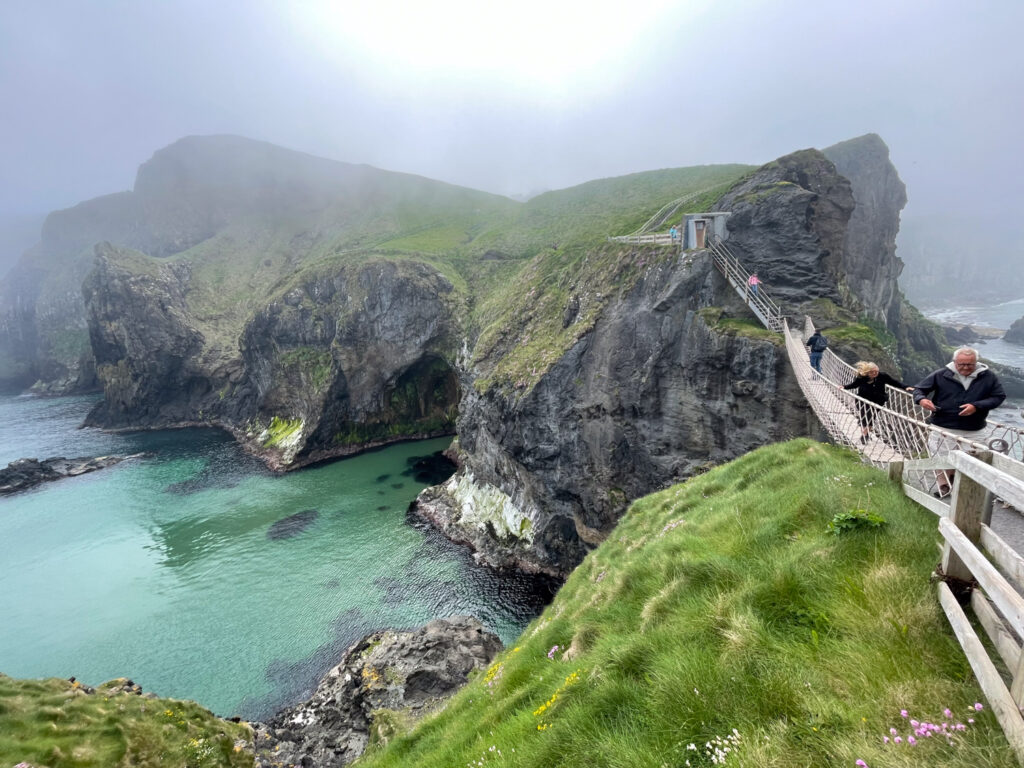
The Experience of Crossing the Bridge
I’m sure you’re curious about the experience of crossing the Carrick-a-Rede Rope Bridge, so here’s my story about it.
From the car park, there is a 15-minute walk to the rope bridge. When I arrived, there was a small line of people waiting. It was only a short queue because it was a foggy day. On sunny days, there are usually more visitors waiting at the bridge.
Staff members are on both sides to monitor the number of people allowed on the bridge at any time. Fortunately, I had to wait only about 5 minutes, and the queue typically moves quickly.
While waiting, I was struck by the height of the bridge. The sight of the wires hanging 100 feet in the air was impressive. As I approached the bridge, I noticed the wooden planks were reasonably close together, with only a small gap between them. That means the rope bridge is easy to cross, and you don’t have to worry about it.
Crossing the bridge took about 30 seconds or less, unless people occupy it for selfies and videos! On the way back, you’ll find a sign for a ‘Bridge Crossing Certificate’ where you can take a photo. Additionally, you can purchase a paper certificate as a souvenir at the Visitor Centre.
If the wind picks up or conditions become too dangerous, the bridge is closed immediately for safety reasons. The staff will monitor the weather and reopen the bridge when it is safe.
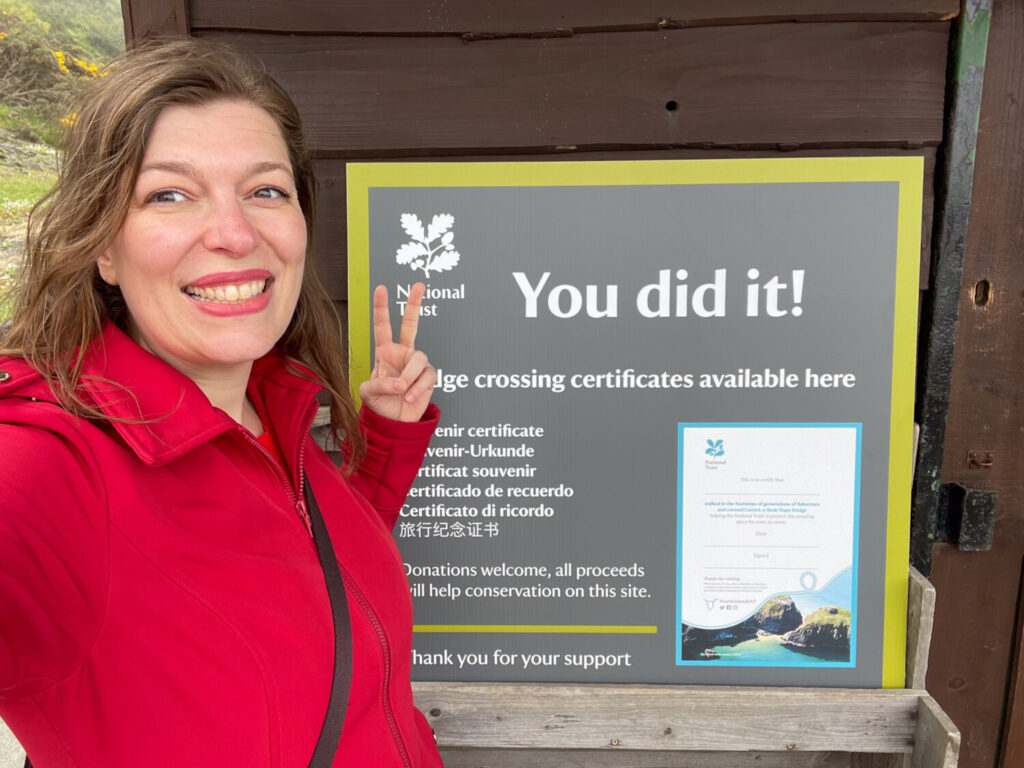
What’s on the Other Side of the Rope Bridge
If you’re brave enough to walk across the shaky 100-foot-high bridge, you will be rewarded with stunning views of the green water below. It truly feels like an incredible experience.
As I reached the other side, I was blown away by the views of the coast. Despite the fog, it was truly amazing. On sunny days you can even see Scotland. I sat down on the small Carrick-a-Rede island and felt a deep connection with the beautiful nature surrounding me.
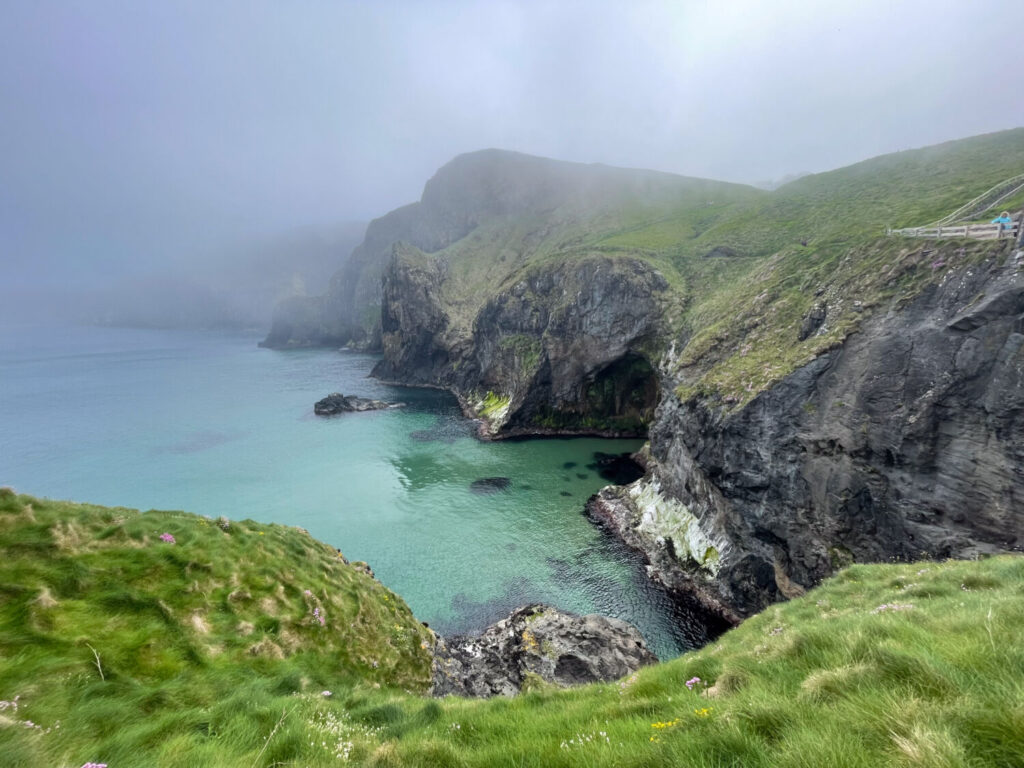
Tips for Your Visit to Carrick-a-Rede Rope Bridge
Carrick-a-Rede Rope Bridge is pretty exposed to the weather, so I recommend dressing accordingly. If you’re visiting in winter, you’ll definitely want warm and waterproof clothes because it can get cold and wet. The coastal winds can catch you off guard even in summer, so layers and a windbreaker are always a good call.
Northern Ireland’s weather can be unpredictable. Just a few hours before, I was at Carrickfergus Castle a few miles away, enjoying the sunshine, and it was utterly foggy when I got to Carrick-a-Rede! So, be prepared for anything.
As for photos, the views around the bridge are absolutely amazing, but just a heads-up: while you’re on the bridge, you’ll need to keep moving to avoid holding up the line. Not everyone can cross at the same time, and there’s often a bit of a wait, so be quick with your snaps!
At the car park, there’s a little café where you can grab snacks, hot drinks, and ice cream. I had lunch there, and the food was decent. If you prefer, you can take your own picnic or grab something to go and enjoy it with a view.
There are toilets on-site, open while the car park is operating, so you can access the facilities before or after your visit.
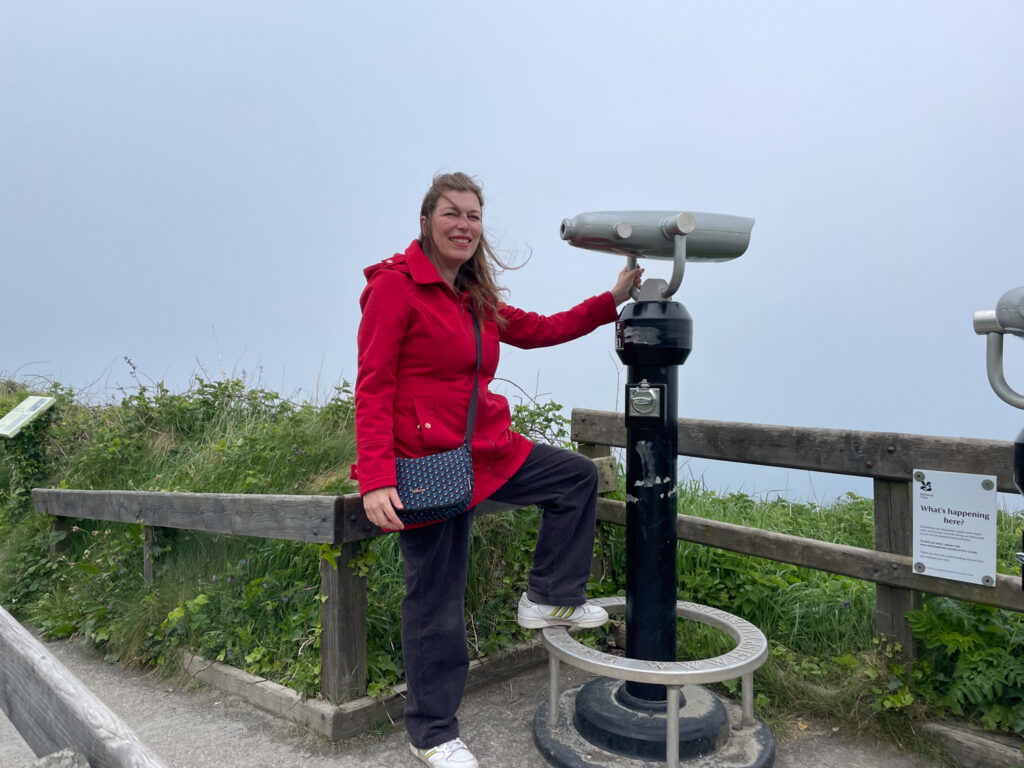
Opening Times
The best time to visit Carrick-a-Rede Rope Bridge is between May and September, when the weather’s usually milder and perfect for a day of outdoor fun. The bridge is open from 09:00 to 16:30 during these months, so you’ve got plenty of time to explore.
Just be aware, it can get pretty busy, especially in the summer months. If you want to avoid the crowds, try going on a weekday or early in the morning. I visited in May during a weekday, and it was a great choice because it wasn’t rainy, just a bit foggy and not too windy compared to later in the summer.
In winter, the bridge opens with a shorter schedule, only from 10:00 to 14:30, but if the wind picks up too much, they’ll shut it down for safety.
Ticket Prices
The official website recommends booking the tickets for the Carrick-a-Rede Rope Bridge online in advance. I did this way, and the good news is that parking is included in the price.
A ticket for an adult will cost you around £14, while kids between 5 and 17 can get in for £7, and under-5s can join in for free. Just keep in mind that during peak season, ticket prices might go up by a couple of pounds, so it’s worth checking the website before you go.
Even if you’re not keen on crossing the bridge, you can still enjoy the short walk from the car park to the bridge. You have just to pay £10 for parking only, which lets you enjoy the site without making the bridge crossing. The walk until the bridge takes about 20 minutes and allows you to enjoy the beautiful coastal views without defying the heights.
If you’re considering multiple National Trust sites, like the Giant’s Causeway, the annual membership could save you some money in the long run, especially if you’re planning to hit up a few more locations while you’re in Northern Ireland.
How to Reach Carrick-a-Rede Rope Bridge
Carrick-a-Rede located along the Giant’s Causeway Coastal Route and pretty easy to reach. It’s about 7 miles from both the Giant’s Causeway and Bushmills, and around 5 miles from Ballycastle. Use your sat nav or Google Maps, and you’ll be guided straight there.
If you’re relying on public transport, Ulsterbus routes 252 and 256 run from Belfast, and there are buses from Coleraine as well. You can find all the details you need on the Translink website.
If you’re up for a scenic hike, Carrick-a-Rede is part of the North Antrim Coastal Path. You can reach the bridge on foot from the Giant’s Causeway, making it a great option for those who want to combine a bit of hiking with their visit to the site.
Carrick-a-Rede Rope Bridge
119a Whitepark Road, Ballintoy, County Antrim, BT54 6LS
Activities Nearby
After crossing the Carrick-a-Rede Rope Bridge, you can enjoy a two-kilometre coastal walk. Keep an eye out for basking sharks, dolphins, porpoises, guillemots, razorbills, kittiwakes, and fulmars.
On Carrick-a-Rede Island, you can visit and even stay at the over 400-year-old listed Fisherman’s Cottage, once used by local fishermen for shelter and to store their equipment.
Lastly, near the bridge, you’ll find the old limestone quarry at Larry Bane, which operated for over 100 years, from around 1870 until it closed in the early 1960s.
Visiting the Carrick-a-Rede Rope Bridge is an unforgettable and exciting experience. You’ll have a great adventure while enjoying the stunning coastal view. Feel free to share your experience in the comment, whether you crossed the bridge or explored the surrounding area.
